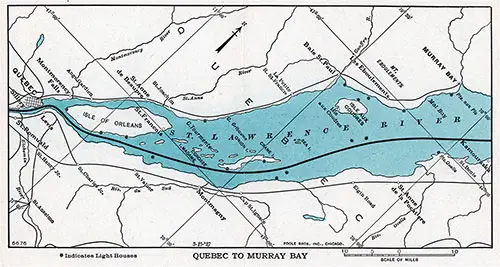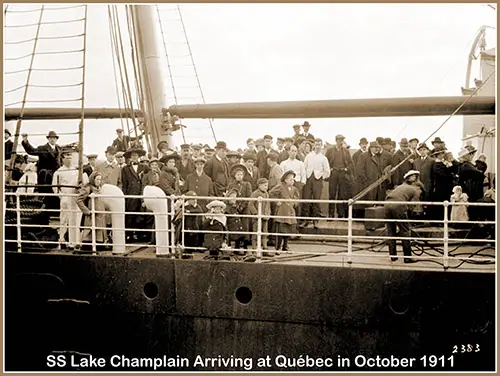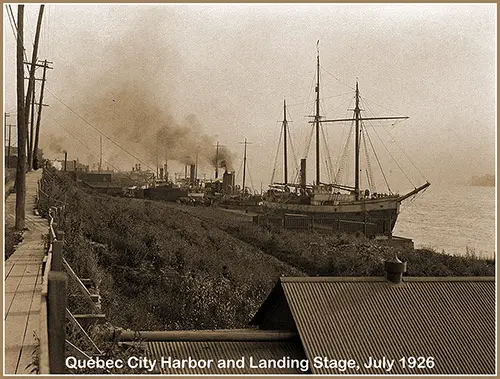Québec Passenger Lists 1891-1960

Map of the St. Lawrence River from Québec to Murray Bay, 1948. | GGA Image ID # 17578a9e21
Québec is the capital of the Canadian province of Québec. The narrowing of the Saint Lawrence River proximate to the city's promontory, Cap-Diamant (Cape Diamond), and Lévis, on the opposite bank, provided the name to the city, Kébec, an Algonquin word meaning "where the river narrows."
The City of Québec (Latitude 46° 48" N., Longitude 71° 13" VV.) is situated on the River St. Lawrence, at the mouth of the St. Charles River, at the head of navigation for vessels of the largest draught. Its population is 120,000.
The Port of Québec has been specially endowed by nature and can be called "The National Port of Canada." It possesses exceptional facilities and is deep enough for the largest passenger and freight steamers afloat. It is large enough to admit the navies of the world.

The Steamer SS Lake Champlain Arriving at the Port of Québec in October 1911. | GGA Image ID # 1d5278af4d
Québec is within six days' run from Liverpool and can be reached at all tide stages, the river being well-buoyed and well-lighted. It is 500 miles nearer Liverpool than New York.
Along the docks of the Louise Basin and Pointe-a-Carcy, there is ample room for the berthing of 22 large ocean-going ships, with a water depth varying from 26 to 40 feet and over at low tide.
During the past seven years, extensive improvements and facilities have been built at the cost of S7,000,000, bringing the total amount expended to over SI3,000,000.
Although it is capable of further developments and profitable additions of docks and piers, its present efficiency justifies its claim to handle a large portion of the Canadian-borne trade, especially yearly diverted to American seaports.
The Port of Québec is one of Canada's greatest assets. It is now fully equipped with all modern appliances. The shipping corporations and grain exporters would undoubtedly find it beneficial to select it as a distribution center on the St. Lawrence River.
Passenger Lists (PLs) available from the GG Archives Calling at the Port of Québec, Canada.
Note: Typically, only the origination and final destination ports are listed in each link. Other intermediary ports of call may not be listed.
======== 1890s ========
Allan Line Royal Mail Steamers
======== 1900s ========
Allan Line Royal Mail Steamers
Canadian Pacific Line
Dominion Line
======== 1910s ========
Allan Line Royal Mail Steamers
Canadian Pacific Line
Cunard Line
Donaldson Line
White Star Line
======== 1920s ========
Anchor-Donaldson Line
Canadian Pacific Line
- 1920-05-08 SS Victorian - Québec to Liverpool
- 1920-07-28 SS Empress of France - Liverpool to Québec
- 1921-09-06 SS Metagama - Liverpool to Québec and Montréal
- 1923-06-22 SS Montrose - Liverpool to Québec and Montréal
- 1923-07-13 SS Montcalm - Liverpool to Québec and Montréal
- 1923-07-13 SS Montlaurier - Québec to Liverpool
- 1923-08-17 SS Metagama - Glasgow to Québec and Montréal
- 1924-05-23 SS Marloch - Glasgow to Québec and Montréal
- 1924-08-14 SS Empress of Scotland - Hamburg to Québec
- 1924-09-05 SS Montroyal - Liverpool to Québec
- 1925-09-11 SS Marburn - Glasgow to Québec and Montréal
- 1926-06-30 SS Melita - Antwerp to Québec and Montréal
- 1927-07-29 SS Montclare - Liverpool to Québec and Montréal
- 1928-05-04 SS Minnedosa - Liverpool to Québec and Montréal
- 1928-07-14 SS Empress of Australia - Southampton to Québec
- 1928-08-18 SS Empress of France - Southampton to Québec
- 1929-07-20 SS Empress of Scotland - Southampton to Québec
- 1929-09-07 SS Montroyal - Southampton to Québec
Cunard Line
- 1923-06-08 RMS Andania - Southampton to Québec and Montréal
- 1924-07-10 RMS Antonia - Cherbourg to Québec and Montréal
- 1924-08-01 RMS Andania - Southampton to Québec and Montréal
- 1924-08-23 RMS Caronia - Liverpool to Québec
- 1924-09-04 RMS Carmania - Liverpool to Québec
- 1925-08-15 RMS Ausonia - Southampton to Québec and Montréal
- 1925-08-21 RMS Alaunia - Liverpool to Québec and Montréal
- 1928-05-04 RMS Ausonia - Southampton to Québec and Montréal
- 1928-08-17 RMS Andania - Liverpool to Québec and Montréal
- 1929-09-29 RMS Ausonia - Southampton to Québec and Montréal
Royal Mail Steam Packet Company (R.M.S.P.)
White Star-Dominion Line
White Star Line
- 1927-04-16 RMS Doric - Liverpool to Québec and Montréal
- 1927-09-09 RMS Albertic - Liverpool to Québec and Montréal
- 1928-05-19 RMS Doric - Montréal and Québec to Liverpool
- 1928-06-14 RMS Albertic - Montréal and Québec to Southampton
- 1928-08-17 RMS Laurentic - Liverpool to Québec and Montréal
- 1928-09-14 RMS Laurentic - Liverpool to Québec and Montréal
======== 1930s ========
Anchor-Donaldson Line
Canadian Pacific Line
- 1931-09-04 SS Duchess of Bedford - Liverpool to Québec and Montréal
- 1932-09-09 SS Duchess of Atholl - Liverpool to Québec and Montréal
- 1932-10-14 SS Duchess of Bedford - Liverpool to Québec and Montréal
- 1932-10-15 SS Montrose - Hamburg to Québec
- 1933-05-12 SS Duchess of Atholl - Liverpool to Québec and Montréal
- 1935-06-12 SS Empress of Australia - Southampton to Québec
- 1937-06-16 SS Empress of Australia - Québec to Southampton
- 1937-08-17 SS Duchess of Richmond - Southampton to Québec and Montréal
- 1937-08-24 SS Empress of Australia - Southampton to Québec
- 1938-08-19 SS Duchess of Bedford - Liverpool to Québec and Montréal
- 1939-08-04 SS Montrose - Liverpool to Québec and Montréal
Cunard Line
- 1930-07-12 RMS Ascania - Southampton to Québec and Montréal
- 1930-09-20 RMS Ausonia - Southampton to Québec and Montréal
- 1931-06-12 RMS Antonia - Liverpool to Québec and Montréal
- 1932-06-04 RMS Ausonia - Southampton to Québec and Montréal
- 1932-09-10 RMS Aurania - Southampton to Québec and Montréal
- 1934-04-28 RMS Antonia - Liverpool to Québec and Montréal
- 1936-07-31 RMS Antonia - Liverpool to Montréal and Québec
- 1937-08-07 RMS Ausonia - Southampton to Montréal and Québec
- 1938-08-27 RMS Alaunia - Southampton to Québec and Montréal
- 1938-10-15 RMS Ausonia - Southampton to Montréal and Québec
- 1939-07-25 SS Carinthia - New York to Québec, Gaspé, and Halifax and returning to New York
Donaldson Atlantic Line
White Star Line
======== 1940s ========
Cunard Line
======== 1950s & 1960s ========
Canadian Pacific Line
- 1950-05-30 SS Empress of Scotland - Liverpool to Québec
- 1950-07-21 SS Empress of Scotland - Québec to Liverpool
- 1951-07-31 SS Empress of Canada - Liverpool to Québec and Montréal
- 1951-08-21 SS Empress of Canada - Liverpool to Québec and Montréal
- 1953-09-15 SS Empress of France - Liverpool to Québec and Montréal
Cunard Line
Note: Typically, only the origination and final destination ports are listed in each link. Other intermediary ports of call may not be listed.
Québec Harbor

View of the Landing Stage and Harbor of Québec, July 1926. | GGA Image ID # 1d531a3d46
Québec is a seaport, yet it is four hundred miles inland on The Harbour, the St. Lawrence river. It is subject to tides, which sometimes fluctuate as much as twenty feet. Owing to the cliff formation of the shores, deepwater wharves to the extent of thirty miles could be built if necessary. With the St. Charles River's vast estuary improved, Québec's harbor could quickly provide shelter for the world's united fleets.
The St. Lawrence river has been carefully dredged as far as Montréal. The resulting ship channel has made the Metropolis of Canada the head of sea-going navigation for the smaller class of vessels.
However, Québec's magnificent deep water harbor can accommodate the largest ships afloat. However, whatever their size, all incoming and outgoing vessels (passengers) stop at Québec. One can often save time using the railway to and from the West. Thus the ancient capital occupies an important place in the maritime interests of Canada.
In this connection, it is interesting to note that four Canadian Pacific liners, which are too large for the ship channel to Montréal, make Québec their Canadian port during the navigation season. These ships are the "Empress of France," the "Empress of Britain," the "Empress of Scotland," and the "Montlaurier."
The Canada Steamship Lines' riverboats are always in evidence in the harbor. Their red funnels and white hulls can easily pick them out. Many of the Canadian Government Department of Marine and Fisheries vessels make Québec their headquarters. During the weekend, the Government boats' familiar blue ensign is usually seen at the King's wharf.
In modern times, an enormous amount of shipping ever anchored in Québec's harbor at one time was undoubtedly the fleet of thirty-three transports, which in September 1914, took over to England the first Canadian Contingent, which was to gain such distinction in the Great War. British men-of-war are often anchored in the river and combined with the frowning Citadel. They seem to increase the feeling of Québec's importance as a military and naval power stronghold.
The port's modern equipment includes the latest grain elevators, refrigerating plants, docks, and wharves. The harbor's progress has been so remarkable that Québec now looks forward to the novelty of being an ocean port during the winter season instead of being closed to navigation during the cold period of the year as she now is.
Chas. Smith, K.C., "The Port of Québec," Monthly Bulleting, American Association of Port Authorities, 1 November 1920, Vol IX, No. 1, pp. 91-94
Related Categories
Ephemera & History
- Allan Line Royal Mail Steamers
- Anchor-Donaldson Line
- Canadian Pacific Line
- Cunard Line
- Dominion Line
- Donaldson Atlantic Line
- Donaldson Line
- Home Lines
- Royal Mail Steam Packet Company (R.M.S.P.)
- White Star-Dominion Line
- White Star Line
Steamship & Ocean Liners
- Alaunia
- Albertic
- Andania
- Antonia
- Ascania
- Athenia
- Atlantic
- Aurania
- Ausonia
- Canada
- Carinthia
- Caronia
- Cassandra
- Dominion
- Doric
- Duchess of Atholl
- Duchess of Bedford
- Duchess of Richmond
- Empress of Australia
- Empress of Britain
- Empress of Canada
- Empress of France
- Empress of Scotland
- Grampian
- Ivernia
- Laurentic
- Letitia
- Marburn
- Marloch
- Megantic
- Melita
- Metagama
- Minnedosa
- Montcalm
- Montclare
- Montlaurier
- Montrose
- Montroyal
- Orca
- Parisian
- Pretorian
- Samaria
- Victorian
- Virginian
⚠️ About Accuracy in Historical Records Research Tip
Context. The GG Archives presents passenger lists as faithfully as possible to the original documents. While OCR is generally accurate, portions of these collections—especially image captions and some transcriptions—are typed by hand and may include typographical or spelling variations. The original manifests themselves also contained clerical inconsistencies (names recorded phonetically, mid-voyage corrections, etc.).
What this means for your research:
- Search variant spellings of names (e.g., “Schmidt/Schmitt/Smith,” “Giuseppe/Joseph”).
- Cross-reference with immigration cards, passport applications, naturalization files, city directories, and newspapers.
- Treat manifests as primary sources with historical quirks—use them alongside corroborating records.
- For place names, consider historical borders and language variants (e.g., Danzig/Gdańsk, Trieste/Trst).
How to cite. When quoting a name from a manifest, consider adding [sic] for obvious misspellings and include a note such as “spelling as printed in original passenger list.”
Need help? If you spot a likely transcription error in captions, feel free to contact us with the page URL and a brief note—we love community input. 🙏
Curator’s Note
For over 25 years, I've been dedicated to a unique mission: tracking down, curating, preserving, scanning, and transcribing historical materials. These materials, carefully researched, organized, and enriched with context, live on here at the GG Archives. Each passenger list isn't just posted — it's a testament to our commitment to helping you see the people and stories behind the names.
It hasn't always been easy. In the early years, I wasn't sure the site would survive, and I often paid the hosting bills out of my own pocket. But I never built this site for the money — I built it because I love history and believe it's worth preserving. It's a labor of love that I've dedicated myself to, and I'm committed to keeping it going.
If you've found something here that helped your research, sparked a family story, or just made you smile, I'd love to hear about it. Your experiences and stories are the real reward for me. And if you'd like to help keep this labor of love going, there's a "Contribute to the Website" link tucked away on our About page.
📜 History is worth keeping. Thanks for visiting and keeping it alive with me.
